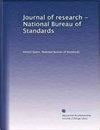Flow Injection-Inductively Coupled Plasma Spectrometry: A New Strategy for Ultratrace Analysis
Journal of research of the National Bureau of Standards
Pub Date : 1988-05-01
DOI:10.6028/jres.093.119
引用次数: 8
Abstract
[I] Snelleman, W., Rains, T. C., Yee, K. W., Cook, H. D., and Menis, O., Anal. Chem. 42, 394 (1970). [2] Epstein, M. S., and O'Haver, T. C., Spectrochim. Acta 30B, 135 (1975). [3] Epstein, M. S., and Winefordner, J. D., Prog. Analyt. Atom. Spectrosc. 7, 67 (1984). [4] McLeod, C. W., Cook, 1. G., Worsfold, P. J., Davies, J. E., and Queny, J., Spectrochim. Acta 40B, 57 (1985). [5] Cook, 1. G., McLeod, C. W., and Worsfold, P. J., Anal. Proc. 23, 5 (1986). [6] Deardorff, E. R., Private Communication, National Bureau of Standards, March 1981. [7] Smith, M. V., and Burke, R. W., Private Communication, National Bureau of Standards, August 1987. [8] Wittman, A., and Schuster, L., Spectrochim. Acta 42B, 413 (1987). [2,3]. In the experiment relatively large volumes of sample are passed through a microcolumn in the flow injection (FI) manifold and retained analytes are subsequently eluted by injection of a small volume of eluent. Activated alumina offers a novel route for analyte preconcentration since it can function both as an anion and a cation exchanger depending upon solution pH. Under acidic and basic conditions alumina exhibits a high affinity for oxyanions and cations, respectively:流动注射-电感耦合等离子体光谱法:超痕量分析的新策略
[I] Snelleman,W.、Rains,T.C.、Yee,K.W.、Cook,H.D.和Menis,O.,Anal。化学。42394(1970)中描述的。[2] Epstein,M.S.和O'Haver,T.C.,Spectrochim。Acta 30B,135(1975)。[3] Epstein,M.S.和Winefordner,J.D.,Prog。Analyt。原子Spectrosc。7,67(1984)。[4] 麦克劳德,C.W.,库克,1。G.,Worsfold,P.J.,Davies,J.E.和Queny,J.,Spectrochim。Acta 40B,57(1985)。[5] 库克,1。G.,McLeod,C.W.和Worsfold,P.J.,分析。Proc。23,5(1986)。[6] Deardorff,E.R.,《私人通信》,国家标准局,1981年3月。[7] Smith,M.V.和Burke,R.W.,《私人通信》,国家标准局,1987年8月。[8] Wittman,A.和Schuster,L.,Spectrochim。Acta 42B,413(1987)。[2,3]。在实验中,相对大体积的样品通过流动注射(FI)歧管中的微柱,随后通过注射小体积的洗脱液洗脱保留的分析物。活性氧化铝为分析物的预富集提供了一种新的途径,因为它可以根据溶液pH同时作为阴离子和阳离子交换剂。在酸性和碱性条件下,氧化铝分别对含氧阴离子和阳离子表现出高亲和力:
本文章由计算机程序翻译,如有差异,请以英文原文为准。
求助全文
约1分钟内获得全文
求助全文

 求助内容:
求助内容: 应助结果提醒方式:
应助结果提醒方式:


